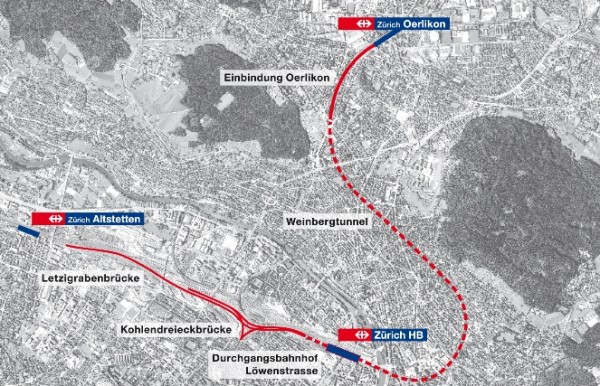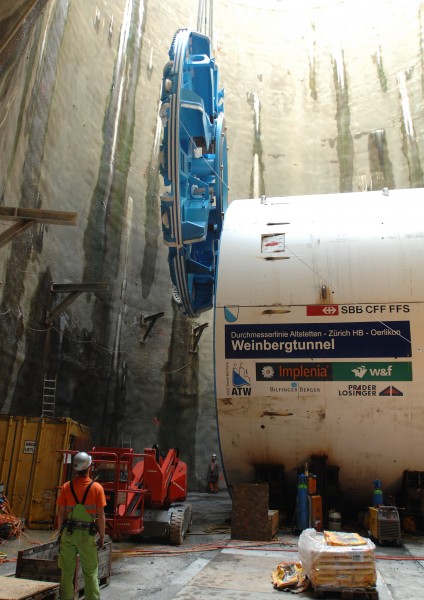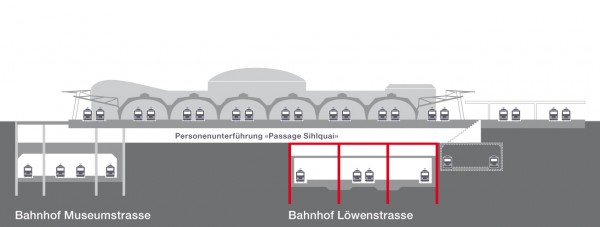Construction of cross-city link helps relieve capacity limits
Posted: 4 August 2010 | | No comments yet
Zurich Hauptbahnhof (Zurich main station, or Zurich HB) is the central hub for rail traffic in Switzerland. Trains pull in and out of the station virtually every minute, and over 300,000 passengers depart, arrive or change trains here daily. Commuter traffic is forecast to grow in the coming years, and over half a million passengers and passers-by are expected to be using the station every day – exceeding its current capacity limits.
Together with other infrastructure expansion projects, the new 9.6km cross-city link will soon ease the bottleneck, enabling new service patterns to be implemented for suburban (S-Bahn) rail traffic from the end of 2013 and for long-distance services as of 2015. The improved services and new connections will be of particular benefit to users of Zurich’s local S-Bahn network and to rail passengers travelling on the Geneva–Berne–Zurich Airport–St. Gallen route.
Zurich Hauptbahnhof (Zurich main station, or Zurich HB) is the central hub for rail traffic in Switzerland. Trains pull in and out of the station virtually every minute, and over 300,000 passengers depart, arrive or change trains here daily. Commuter traffic is forecast to grow in the coming years, and over half a million passengers and passers-by are expected to be using the station every day – exceeding its current capacity limits. Together with other infrastructure expansion projects, the new 9.6km cross-city link will soon ease the bottleneck, enabling new service patterns to be implemented for suburban (S-Bahn) rail traffic from the end of 2013 and for long-distance services as of 2015. The improved services and new connections will be of particular benefit to users of Zurich’s local S-Bahn network and to rail passengers travelling on the Geneva–Berne–Zurich Airport–St. Gallen route.
Zurich Hauptbahnhof (Zurich main station, or Zurich HB) is the central hub for rail traffic in Switzerland. Trains pull in and out of the station virtually every minute, and over 300,000 passengers depart, arrive or change trains here daily. Commuter traffic is forecast to grow in the coming years, and over half a million passengers and passers-by are expected to be using the station every day – exceeding its current capacity limits.
Together with other infrastructure expansion projects, the new 9.6km cross-city link will soon ease the bottleneck, enabling new service patterns to be implemented for suburban (S-Bahn) rail traffic from the end of 2013 and for long-distance services as of 2015. The improved services and new connections will be of particular benefit to users of Zurich’s local S-Bahn network and to rail passengers travelling on the Geneva–Berne–Zurich Airport–St. Gallen route.
The cross-city link traverses the city of Zurich in a broad arc running from Altstetten via the main station to Oerlikon. Löwenstrasse station, the second underground station at Zurich HB, will form the heart of the link line. Westwards, the line leads over two new bridges to Altstetten, while to the north the Weinberg tunnel connects the main station with Oerlikon.


Map Overview
Overview of overall project
The cross-city link runs predominantly through flat but densely developed urban terrain. Construction of the double-track alignment thus involved passing either over or under various constriction points. As a result, the line features a number of steep inclines, which in places are engineered to gradients even stiffer than those of the transalpine Gotthard line.
Weinberg tunnel and Löwenstrasse station: core sections of the cross-city link
The Weinberg tunnel section of the cross-city link is divided into two lots: A ‘mined cut-andcover’ method is being used to tunnel under Zurich HB’s south wing. The second lot comprises a circular-section double-track tunnel extending from the shaft under the south wing to the tunnel portal in Oerlikon, plus a parallel escape and rescue tunnel.


Tunnel Boring Machine (TBM)
Construction beneath the main station’s south wing
Between the double-track tunnel and Löwenstrasse station, a widened cavern is being excavated to allow the two tracks to splay out into the four-platform Löwenstrasse station. These structures are being built at a vertical distance of approximately 6m beneath the south wing of Zurich main station, which is a protected 150-year-old building. The station’s current sub-surface levels already house large infrastructure supply operations for the shopping centre and catering businesses located there, and construction work must not be allowed to adversely affect them.
Starting from a construction shaft sunk directly in front of the east facade of the south wing, two longitudinal galleries – each measuring 110m-long and approximately 6mhigh are being dug and secured by shotcreting, extending to the future Löwenstrasse station. The centre-to-centre distance between these two tunnels is approximately 12m at the construction shaft front wall and some 40m at the lot boundary. Slurry diaphragm walls (measuring 20m-deep, and 80cm-thick) are to be sunk around these galleries to serve as the outside walls of the later tunnel.
A system of transverse galleries will then be constructed between the longitudinal galleries to construct the tunnel roof. Pre-stressed concrete supporting beams will be successively integrated into these galleries and then joined together to form the tunnel roof. Underneath the secured supporting structure of this roof and the slurry walls installed on both sides, excavation can then be completed and the slurry walls secured section-wise by means of bracing. This will be followed by installation of the base slab and the final tunnel walls. Extensive work to lower the groundwater table will accompany these activities.
Double-track tunnel
Starting tunnel excavation work with a heading driven from the future portal in Oerlikon would have restricted work in the fourth section of the cross-city link, thus preventing the tunnel from being completed on schedule. It was therefore decided to commence excavation of the Weinberg tunnel via a 40m-deep access tunnel. A site opposite the offices of Radiostudio Zürich about 120m from the tunnel portal in Oerlikon proved suitable as a location for this access shaft.
Starting from the end of the access tunnel, two tunnel headings were driven in opposite directions: first, a heading was bored in the direction of Oerlikon station right up to the mined portal of the Weinberg tunnel, using shotcreting to secure the vault, stope and base.
In addition, work began from the same access tunnel in October 2008 to drive the main heading for the Weinberg tunnel in the direction of Zurich HB using a mix-shield tunnel boring machine. A total distance of approximately 4,400m is being bored, and the boring diameter is 11.30m.
Owing to the eccentric orientation of the access tunnel to the Weinberg tunnel axis, dictated by local conditions, the tunnel boring machine (TBM) was unable to start work directly from the access tunnel. It was partially preassembled in sections inside the access shaft which were then pushed obliquely into the main tunnel axis. There, the TBM assembly was completed in a specially prepared assembly cavern and in the previously finished section of tunnel.
Since that time, over 4,141m of tunnel have been bored (as of early June 2010). Tunnelling successfully worked through the Buchegg rock depression, after this had previously been investigated. At that location, the molasse rock layer came down to the tunnel roof level. A stratum of lime separated the molasse from the unconsolidated rock lying above it. Prior to the commencement of work, the water table was lowered by means of wells so that tunnelling could continue through the rock depression without a change of boring method.
The lining of the Weinberg tunnel is a dualshell design consisting of an outer shell made from steel-reinforced concrete segment rings generally 30cm-thick (but 60cm-thick along the base) and an inner shell of non-reinforced castin- place concrete, likewise 30cm-thick.
The soil conditions where the tunnel passes underneath the Limmat River require a change in boring method. There the TBM will be modified so that it can operate with a hydraulically-supported excavation face. Refitting operations will include modifying the spoil removal system to convey fluids. The stope working space will be completely sealed off from the portion of the tunnel at atmospheric pressure so that pressure can be applied to it subsequently in order to enhance excavation face operations. The equipment on the backup train will be appropriately equipped for fluid conveyance.


A sketch of Löwenstrasse station
Löwenstrasse through station – heart of the cross-city link
The new underground Löwenstrasse through station, conceived as the heart of the cross-city link line, is currently under construction 16m-below platforms 4 to 9 of Zurich HB, with work ongoing during regular railway operations.
Planning engineers face particularly daunting challenges to construct these new platforms: train traffic at Zurich HB is so heavy that the rail operator cannot afford to close down even one single track during construction. Work is thus being executed using the cut-and-cover construction method. This entails shortening two or three platforms at a time by 100 metres short of the original buffers. The space won in this way is then available to allow construction work.
Furthermore, as the new Löwenstrasse through station is being constructed directly underneath the River Sihl, a slab is having to be laid under the riverbed to seal it. Sections of river between Postbrücke and Zollbrücke are thus being drained. Work is being performed between two out of five culverts isolated by floodgates. After completion of the work, the natural riverbed will be restored and reflooded. Once this slab is installed, the ground can be excavated. The interior construction and finishing work will then follow step-by-step, right through to laying the tracks and installing all technical systems and equipment.
Rail equipment for the cross-city link – procurementInvitations to bid are expected to be issued in summer 2010 for the following three lots: Lot 23.1General contractor for rail equipment, with provision of the following:
The general rail equipment contractor also assumes the task of overall coordination of all other contractors involved in project implementation. Lot 23.2Overhead power lines, with provision of the following:
The following lot will not be openly issued in a call for bids but will be executed in accordance with an existing framework agreement: Lot 23.3Wireless radio equipment contractor (for installation of the following equipment):
Publication of invitation for tenders: scheduled for end-August 2010. Preliminary information and publication: www.simap.ch Further information: www.durchmesserlinie.ch Timeframe for execution: 2012-2013 |
About the Author
Marco Ceriani
After completing a degree in structural engineering, Marco Ceriani worked for an engineering company as a Project Manager for tunnel maintenance and structural engin – eering. He then went on to obtain a postgraduate qualification in economics, before becoming Product Manager of the ground and rock anchor division of an industrial construction company. Since 1997, Marco Ceriani has been with Swiss Federal Railways SBB as its representative towards general contractors. For four years he was responsible for the company’s existing underground building projects, and since then he has headed the Weinberg tunnel section of the Zurich cross-city link since the start of the project.








